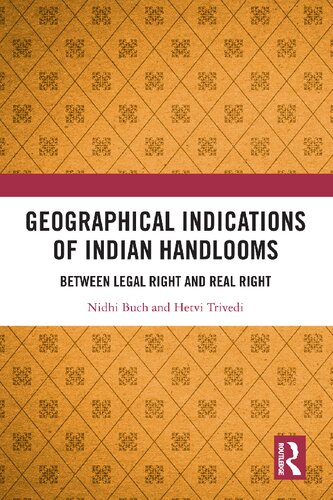

Most ebook files are in PDF format, so you can easily read them using various software such as Foxit Reader or directly on the Google Chrome browser.
Some ebook files are released by publishers in other formats such as .awz, .mobi, .epub, .fb2, etc. You may need to install specific software to read these formats on mobile/PC, such as Calibre.
Please read the tutorial at this link. https://ebooknice.com/page/post?id=faq
We offer FREE conversion to the popular formats you request; however, this may take some time. Therefore, right after payment, please email us, and we will try to provide the service as quickly as possible.
For some exceptional file formats or broken links (if any), please refrain from opening any disputes. Instead, email us first, and we will try to assist within a maximum of 6 hours.
EbookNice Team

Status:
Available4.6
38 reviewsThis book presents a comprehensive analysis of Geographical Indications (GI) in the Indian context with particular reference to the handloom sector. It discusses themes such as the rationale of GI as IP (Intellectual Property); the domestic position on GIs; GI protection under various international instruments; handlooms from Gujarat and their GI journey; efficacy of Geographical Indications; and GI structure for handlooms. The volume fills the gap between law and policies, and recommends the implementation of an efficient legal system. It highlights the status of Indian handlooms, a sector that represents the country’s cultural heritage and supports several livelihoods. The authors examine India’s GI protection system with its diverse cultures and explore how GI can help recognize, uplift and promote these products to bring socio-economic benefits. The work documents policy measures undertaken for the revival, restructuring and promotion of Indian handlooms and handicrafts, and will serve as an important intervention in Indian law on GI.
An investigative study that evaluates the current law and policy on GI protection through detailed case studies and empirical research on select Indian handlooms, this book will be useful to scholars and researchers of geography, economics, development studies, sociology, law and public policy. It will also interest policymakers, legal practitioners, textile and handloom professionals, design and business administration institutes, media, arts and crafts museums, and civil society organizations working on handlooms or Intellectual Property.